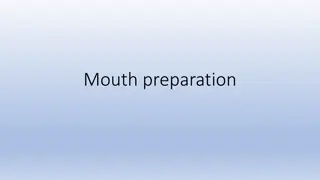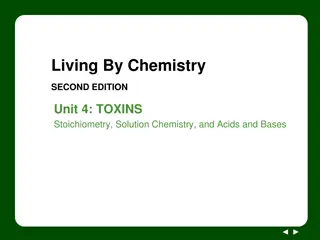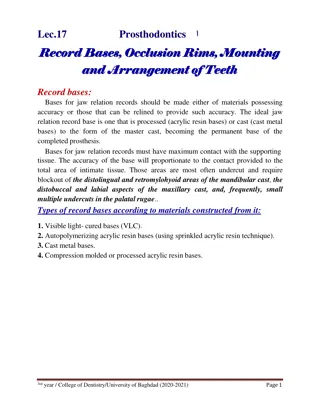Understanding Ointments: Types, Bases, and Preparation Methods
Ointments are semi-solid preparations used for external application on the skin or mucous membranes. They can be medicated or non-medicated, with different bases like hydrocarbon, absorption, water-removable, and water-soluble. Factors affecting base selection include drug release rate, absorption, occlusion, stability, and ease of removal. Methods of preparation include incorporation and fusion, with incorporation involving mixing components to create a uniform blend.
Download Presentation

Please find below an Image/Link to download the presentation.
The content on the website is provided AS IS for your information and personal use only. It may not be sold, licensed, or shared on other websites without obtaining consent from the author. Download presentation by click this link. If you encounter any issues during the download, it is possible that the publisher has removed the file from their server.
E N D
Presentation Transcript
Ointments By : Lecturer Ebtihal Abdul kadhim Assist lecturer Zahraa Amer
Ointments Ointment can be defined as a semisolid preparation intended for external application to the skin or mucous membranes medically, ointments may be divided into: Non _medicated ointment: This may be used as a protector, emollient, lubricant or may be used as a vehicle for topical application of therapeutic agent Medicated ointment: Used for topical therapeutic effects.
Classification of ointment bases: Hydrocarbon bases (oleaginous bases). Absorption bases. Water removable bases. Water soluble bases.
Factors that affect selection of appropriate bases Desired release rate of the drug substance from the ointment base Desirability for topical or percutaneous drug absorption Desirability of occlusion of moisture from the skin. Stability of the drug in the ointment base. Effect of the drug on the consistency or other features of the ointment base. The desire for a base that is easily removed by washing the water.
Method of preparation of ointment: Incorporation. Fusion
Note: Methods used for preparation of ointment depend on the nature of ingredients.
Incorporation: By this method, the components are mixed until a uniform preparation is attained; this is done by using mortar and pestle or slab and spatula. We can sub divided this method into: A) Incorporation of solids B) Incorporation of liquids:
A) Incorporation of solids: The ointment base is placed on one side of the working surface and the powdered components (previously reduced to fine powders and thoroughly blended in a mortar) on the other side a small portion of the powder is mixed with a portion of the base until uniform ;the process is continued until all portions of the powder and the base are combined and thoroughly and uniformly blended.
Notes When an ointment is prepared by spatulation ,the pharmacist works the ointment using a stainless steel spatula having a long ,broad blade and periodically removes the accumulation of ointment on the large spatula with a smaller one. If the components of the ointment are reactive with the metal of the spatula (as in phenol for example) , hard rubber spatula may be used. Solids that are soluble in a common solvent that will NOT affect the stability of the drug or the efficacy of the product may first be dissolved in the solvent and the solution added to the ointment base by spatulation or by using a mortar and pestle. It is desired to reduce the particle size of a powder or crystalline material before incorporation into the ointment base so that the final product will not be gritty. This may be done by levigation (mixing the solid material in a vehicle which it is insoluble to make smooth dispersion).
NOTE The levigating agent used for example: mineral oil for oleaginous bases where oils are the external phase or glycerin for bases where water is the external phase. The levigation is done using mortar and pestle.
B) Incorporation of liquids: When it is necessary preparation to hydrophobic base. The solution first may be incorporated minimum amount of a hydrophilic base and then that mixture added to the hydrophobic base. to add an aqueous into a
Notes: Liquid substances or solutions are added to an ointment due consideration of an ointment bases capacity to accept the volume required .e.g.: only very small amounts of an aqueous solution may be incorporated into an oleaginous ointment whereas hydrophilic ointment bases readily accept aqueous solutions. Mortar and pestle are used when we want to incorporate large quantity of liquid or if large quantity of ointment is wanted to be prepared.
Fusion By fusion method, all or some of the component of an ointment are combined by being melted together and cooled with constant stirring until congealed. Component not melted are added to the congealing mixture as it is being cooled and stirred.
Melting of the substances is done by one of the following three methods the material with the highest melting point are heated to the lowest required temperature to produce a melt, the additional materials then are added with constant stirring during cooling of the melt until the mixture is congealed. Melting the component having the lowest melting point first then adding the remaining components in order of their melting points. Melting the entire component together under slowly increasing temperature.
Notes Heat labile substances and any volatile components are added last when the temperature of the mixture is low enough not cause decomposition or volatilization of the components. Solutions and insoluble powders (levigated with portion of the base) may be added to the congealing mixture. The fusion process may be conducted in a porcelain dish or glass beaker. The fusion method is used when we have waxes ,paraffin ,fatty alcohol ,fatty acids, or any hard waxes in the prescription and also used when we have medicament soluble in melts base. The fusion process may be conducted in a porcelain dish or glass beaker.
Rx Simple ointment (B.P) Wool fat 50g Hard paraffin 50g Ceto acetyl alcohol 50g Yellow soft paraffin 850g Method of preparation: We weight the ingredients ,then we take the one with the highest melting point, put it in the beaker and in water bath till it melt (hard paraffin) then we add another ingredient with the lower m.p.(ceto acetyl alcohol) then wool fat, soft paraffin .After they melt we leave the beaker to cool ,then the content will be semisolid.
Rx Zinc oxide ointment (B.P) Zinc oxide 150gm Simple ointment 850gm Method of preparation : We put the ointment base on the slab and gradually add to it a powder of zinc oxide ,then mix the quantity of the ointment base with powder mix until it will be homogenized. *zinc oxide as astringent and protective action used in napkin rash.
Rx Zinc and caster oil ointment (body cream) (B.P) Zinc oxide 7.5gm Caster oil 50gm Cetostearyl alcohol 2gm White bees wax 10gm Arachis oil 30.5gm This Rx is ointment rather than cream but due to the present of caster oil it gives them smooth appearance.























